Interview with Joe Rohde, Imagineer Behind Animal Kingdom, Aulani, and More–DD011
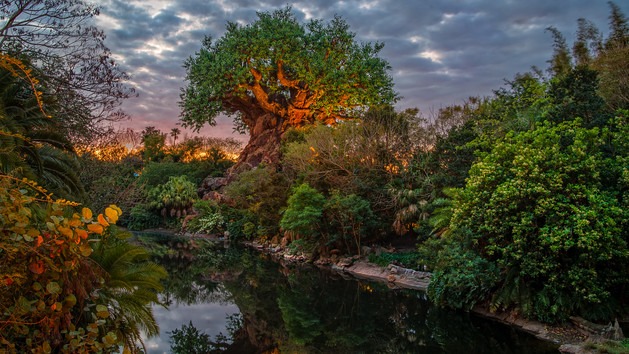
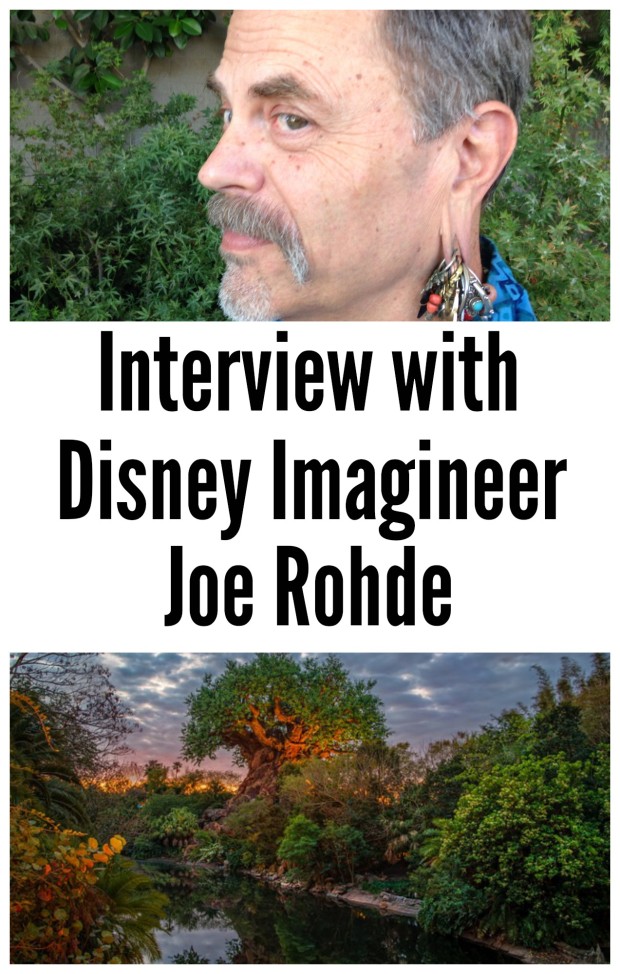 Joe Rohde, the creative genius behind the Adventure's Club, Animal Kingdom, and Aulani Resort in Hawaii joins us to talk all about his career at Disney and experience designing theme parks.
Joe Rohde, the creative genius behind the Adventure's Club, Animal Kingdom, and Aulani Resort in Hawaii joins us to talk all about his career at Disney and experience designing theme parks.
We talk about how the creation of the Animal Kingdom was really a first for the Disney company and inspired future projects. Now, whenever a project that has a similar theme or concept (like the Aulani) comes into the picture, it falls under Joe.
My favorite part of this week's talk was the examination of Joe's famous earring.
This week's Disneyland Secret features the Pirates of the Caribbean and a story that was told to me by my friend Dave Smith, the founder of the Disney archives.
We also have an exclusive Disney Imagineering pin to giveaway. Click here for info>
In this article:
Click The Play Button Below to Listen:
Joe Rohde Imagineer Pin Contest For You
I was able to secure an exclusive Walt Disney Imagineering logo pin to giveaway on the show. To enter, simply leave a comment on this article below with your opinion of the show, question for Joe, or fun fact. Click here to comment> Now, I can't require you to leave an iTunes review to enter the contest, but each positive review really helps out the show. Please just copy and past the comment that you leave below and leave it as a review on iTunes.
Here's the awesome pin:
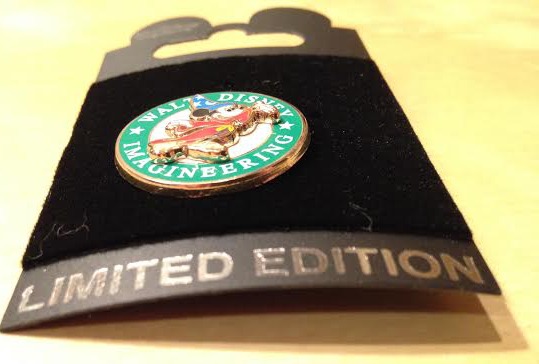
Some Resources We Mentioned:
- Joe Rohde's Website and Blog
- Full information on the Aulani and history
- Season Pass Podcast Interview with Tony Baxter and Marty Sklar
- Joe Rohde Instagram and Twitter
- Avatar Land Information For What's Coming Next
Here's the full Imagineer Joe Rohde interview:

So Joe, what does your current position of ‘creative director' mean at Imagineering?
Joe Rohde: A creative director becomes less of a designer. This is a big split actually in people’s career paths. A director has to learn how to make use of other people: of their decisions, of their vision, of their creative preferences; how to coordinate all that towards a common vision. But a director is not any longer really a designer. You have to kind of step away from design a little bit and be able to articulate a vision in a way that other people can share it. So that they are the designers, and they have room to design, they have room for their own opinions, they have room for the things they would like to do, and yet, all those things are consistent with what you want to do.
There’s a lot of work in separating yourself from a specific visual opinion. So, you can go back one step and go, “Look! Whatever it is, this thing needs to look really scary, and it needs to be in a bluish area of color–cool tones. And it’s got to fit inside this space, so you just know it’s not going to be any bigger than X. And it forms this very important point in the story right about here.” Those things are true. They’re going to stay true. Exactly what it is, that’s up to you, designer person.
When you start out as a designer–I started out as a designer–as you move through your career path, of course you’re always getting direction from other people and having to do these designs. There’s a certain level of frustration in that you’re the designer and you are constantly being told what to do by other people. So you’re waiting for this day when you get to be the director, then you get to tell other people what to do. But that’s not what happens, right. When you get to be the director, you actually have to learn how to let other people do what they want to do, but describe the work in such a way that it’s consistent with an overall direction.
My job is setting vision, making sure that that vision is understood by the team who’s going to do the work, making sure that that vision is understood by the executives and outside people who are going to reveal it. So that whenever we talk about an idea, we’re all talking about the same thing. So we’re not getting direction that is sideways from what we’re trying to do. And then, guiding the people towards the most effective way of expressing these ideas. It’s rare for me to sit down with a piece of paper and draw a design. And usually if I do, it’s a very simple sketch. So there’s a lot of responsibility towards vision, there’s a lot of responsibility towards making sure that you have put together a team of people who are properly balanced with each other, and there’s a lot of responsibility outwards, representing the wok that that team is doing and representing back to the team what is the outside impact on the work we’re doing. That’s kind of what a creative director wants to do.
It sounds kind of like what Walt Disney had to do back in his day, in balancing everything and making people produce their best work?
Joe Rhode: Yeah, Disney didn’t spend a lot of time drawing, right? He spent a lot of time talking, and that is kind of the director’s job. If you find yourself drawing too much, you’re a designer, which is fine. You could be a great designer, but you’re unlikely to be directing if you’re spending a whole lot of time drawing. So, you really have to find a way–everyone’s method is different–to push off from that and be able to let people do their work.
My background is pretty equal between writing and drawing or between writing and design. So, my group of designers is pretty biased towards writing-based models. We do a lot of talking, we do a lot of writing, we do a lot of story-based setup before we start to draw. We don’t draw first. We talk first and then draw.
Interesting. And now, is everyone’s goal to get to where you are today? And when you started, did you say, “Oh, I want to have a leading project someday?” And how did you start with Imagineering?
Joe Rohde: Well, my early career is completely disorganized and accidental. So, I was recruited to be just a worker when we were building up Epcot. I had been teaching set design and doing set design at a high school in the San Fernando Valley. One of the executive’s kids went to that school; he kind of recruited me. But then of course, for quite some time, I was no longer directing anything. I came in at a very, very basic entry level job in the model shop. I did not have any kind of cohesive vision of something I wanted to do or wanted to be at Imagineering. But I did know that I had a body of skills to offer that at least my first job was not requiring of me.
And so, it probably took about four years for me to end up in a job where the skills that I had most well developed were now being asked of me. And now, I could move forward into progressively more and more directorial positions. And it probably took about eight years until the Adventurers Club before I was like in-charge of something that was my idea, where the things that are going to happen are going to be more or less described by me, and in the end, I’m going to be the guy who says “I am responsible for that project” and it looks like what I thought it was going to be and is a thing that I was in charge of. And that would be the Adventurers Club which opened in ’89, and I started working on in ’86-’87. So, you can follow that timeline from starting here to being in-charge of something–not a huge thing, but something. And then of course, the weird part is I went from that to Animal Kingdom which is a giant jump.
It sure is a giant jump. You were working on Epcot and then some other projects after that, then how did you get your first project? Did they just noticed you?
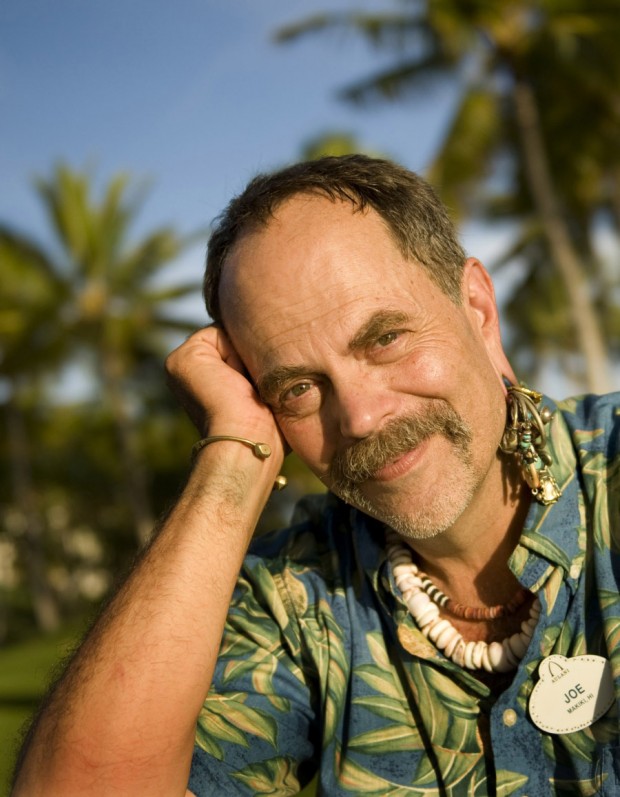 Joe Rohde: Yeah. Okay, so I had been working with a specific designer–very, very competent, hardworking, knowledgeable designer–very good mentor, but not a very good speaker. So he’s a very good artist. This is a common problem with artists. They could be very good artist and not very good at speaking or talking. It’s a very common problem. The obvious kind of choice that people make in their life is they develop and they end up being very good as an artist or a designer, and they just don’t end up being very good as a speaker. So I’m a very good speaker, and so whenever we have presentations, I would end up being the guy doing the talking. So if you were the guy doing the talking, you have to answer questions. And once you answer questions, now you’re in a conversation. Once you’re in a conversation, people are going to ask your opinion.
Joe Rohde: Yeah. Okay, so I had been working with a specific designer–very, very competent, hardworking, knowledgeable designer–very good mentor, but not a very good speaker. So he’s a very good artist. This is a common problem with artists. They could be very good artist and not very good at speaking or talking. It’s a very common problem. The obvious kind of choice that people make in their life is they develop and they end up being very good as an artist or a designer, and they just don’t end up being very good as a speaker. So I’m a very good speaker, and so whenever we have presentations, I would end up being the guy doing the talking. So if you were the guy doing the talking, you have to answer questions. And once you answer questions, now you’re in a conversation. Once you’re in a conversation, people are going to ask your opinion.
And so, I become the guy that people are asking the opinion of, because I’m the guy doing the talking. And that gives me a chance to demonstrate that I have an opinion and that my opinion is worth listening to. And that begins to get me into other meetings that aren’t related to the work that I’m doing. And I become a person who can be in a brainstorm. I become a person who can be involved in creating ideas. Once you’re a person who’s creating ideas, someone has to take responsibility for getting the ideas done. And so slowly, I can become the guy who takes responsibility for getting the ideas done.
And that gets me to the point where someone says, “Well, why don’t you take that idea–that’s your idea–and do it. And the only weird thing in there is the giant jump from the first idea to the second idea. And that was mainly a function of the fact that not very many people were interested in the animal-related project when I first showed up. I was particularly interested. And so, there wasn’t a lot of competition. Otherwise, I can’t imagine that a person with my background would have been given the assignment.
So you’re put on the Animal Kingdom, and from there, that was a long development process.
Joe Rohde: Yes. We opened the Adventurers Club, had a little interim project working on a gallery show in the Mexico pavilion–tiny little thing. And then I was offered this chance to work on the animal project that was eventually Animal Kingdom. That was 1990. And it was opened in ’98, so it was five years of work before it got a capital authorization to begin construction.
That actually was good for us, because we had a very small team. We didn’t really cost the company very much money, because our team was very small. And that allowed us to go for a long time before we had to make a decision. And that allowed us to learn a lot about animals, about conservation, about all these new rules that we would have to invent in order to be able to do a park that was about a subject so different from any subject that had led to a park before. And the look and the feel of Animal Kingdom is very much determined by the idea that this subject of live animals is more realistic, more political, more real world, more involved with negotiation, more involved with outside people from outside of the theme park business than what we had done before.
Yes, incredible project and incredible park now. And now you are still working on that park?
Joe Rohde: Well, Animal Kingdom has gone forever. So really, from the very first morning that anybody sat in a room to talk about Animal Kingdom until this morning–the meeting I just came from– I’ve been working on Animal Kingdom. Partly because the skills necessary to do Animal Kingdom become very specific, because of all those other things, all the design rules that are related to the animals. And that sort of bleeds into the whole park: the realism of the park, the research of the park, the way in which the stories in the park are a little bit more unresolved, the behaviors a little bit unscripted. That all becomes this sort of learned pattern of design, a pattern of design that we Animal Kingdom people are particularly trained in. I meet every Friday morning, and we go over Animal Kingdom issues with the SQS team and with the designers. I’ve been working on Animal Kingdom forever since it opened.
And you’re still creative director?

Joe Rohde: Still creative director over Animal Kingdom. But then, Animal Kingdom becomes kind of the epicenter of other ideas that are kind of like it somehow. Like Aulani is not an animal park. But it is involved in very high levels of research into a subject that is not one of our intellectual properties or creative properties; and involves negotiation with people who are not only not part of Disney but not even part of our industry–that being indigenous Hawaiians; and involves a level of texture and design that is more real than the typical, idealized situations you see at the theme park, and on and on and on. And therefore, falls inside of a kind of an Animal Kingdom portfolio type of work, and therefore, comes to myself and my portfolio. It happens like that. So it’s more loosely related in that it’s going to involve a lot of research, it’s going to involve a lot of negotiation; it doesn’t involve a lot of company-owned intellectual property, you know. It is related to the outside real world. Those things tend to come my direction as jobs.
Let’s talk a little bit about the Aulani project and how that got started in Disney and Hawaii? And what’s the history behind that? Why did Disney decide to go to Hawaii?
Joe Rohde: Well you know, there are a lot of reasons why [Disney decided to built Aulani]. We had a lot of guest information, a lot of internal information that our own demographic people, our own people, our own guest would love to see us do something in Hawaii. But the truth is land in Hawaii is very, very precious. It’s hard to get land in Hawaii. And the land you want is beach front property. And when you invest in beach front property, there’s a whole trigger mechanism of the scale of what you have to build to make your investment back, because the property’s expensive.
You end up knowing that you’re going to build something pretty big–15 stories–just by buying the property that just comes with the territory. So then the question is, how are we going to distinguish this property from everybody else who’s already bought beach front property and built something on a Oahu, all of which are 15 stories tall, all of which are on the beach? They all have a lobby, they all have a nice restaurant and a buffet restaurant, they all have a little spa, they all have a couple of bars, they've got a pool, and they’re on the beach and they have rooms. So what are you going to do that hasn’t been done before?
And again, so our job then is to think about that model. What can we do with this model that hasn’t quite been done before? And the way we went about that was just thinking, let’s go back and look at the decision to go to Hawaii, look at the advertisements, look at the way Hawaii is positioned. And if you look at all that, you look at the arguments–the marketing arguments–that people make for coming to Hawaii. They always feature the Hawaiians. There’s always a person in a hula skirt or a guy blowing on a conch shell trump or someone dancing hula.
The culture of Hawaii is the way in which Hawaii distinguishes itself from other beachy tropical destinations. Hawaii is Hawaii because of Hawaiians. So if Hawaii is Hawaii because of Hawaiians, then Hawaiians are the destination. That’s the destination. Otherwise, I could go to Saint Kitts, I can go to Malibu, right, I could go to Tahiti, or I can go to the Philippines. I can go all over the place. Why am I going to Hawaii? So once you make the decision that Hawaiians are what makes Hawaii Hawaii, now we can have a thematic idea that we can begin to work on and set up a design pattern, a design method that involves Hawaiians.
So basically, what we did is we took the entire project. I mean, everything: carpet patterns, drapery patterns, everything, doorknobs, everything and decided that Aulani would be based entirely on Hawaiian points of view about what makes Hawaii Hawaii. And that would make our 15-story beach front hotel look completely different from anyone else’s 15-story beach front hotel anywhere else in Hawaii. And that’s what happened.
And it has turned out amazingly. I’ve been over there once now and spent three days and really submerged myself. You never want to leave.
Joe Rohde: Oh, it’s pretty interesting. And interesting too, because I think people come away from Aulani with a richer understanding of what Hawaii might really be. Remember, Aulani is a place, so people are going to come back to again and again. And I believe that by taking that journey, you become more comfortable visiting the rest of Hawaii, more knowledgeable about visiting the rest of Hawaii. It increases your confidence about going out into Hawaii, and it will increase your knowledge and understanding of what you see. I don’t think people would keep coming to Aulani and just staying at Aulani forever. I think it becomes a machine and engine by which you understand how to enjoy Hawaii better.
And not the corporate, other company way to do a Hawaiian vacation?
Joe Rohde: No, there’s a way that you get caught in this loop. Frankly, it’s a market research-based loop of like, “This is what people expect, so this is what we’re going to do.” And you go around and around and around and around, and you end up with a product that isn’t different enough from where I came from, you know. You take this great big journey getting to Hawaii. For anyone who’s not from Hawaii is a giant journey. You’re going to cross the ocean, either on a boat or an airplane. It takes time, it’s a big deal, you have to prepare for it. It’s not a casual decision.
When you get to the other side of that journey, you want to feel like you’ve got somewhere. Like when you walk through the door, it’s like we’re not in Kansas anymore. This is a different place from where I came from. In order for it to be different, it can’t be based on what you already expect, or by definition it won’t be different. It has to be based on something that it has to say itself. That’s what makes it different. That’s how you know you got some place new is because it isn’t just what you said you wanted. It’s more and sideways from just what you said you wanted. It’s all the things you want, but it’s not just the things you want, because that would be like not leaving home. You already know you want those things. You already know you need those things. There’s no new news there; there’s no new discovery there.
That’s not why you travel. You’re traveling to be somewhere else, and in order for that place to be somewhere else, it has to have an opportunity to be itself. And that’s what we’re trying to do with Aulani. So, when you get to Aulani, you really have arrived some place that is not like home.
That lobby, just walking in, you can tell. Could you talk a little about working with Hawaiians and how you made it truly Hawaiian?
Joe Rohde: Yeah, sure. I mean, there are all kinds of things here, you know. Hawaiians have a very specific attitude about places, for example. There is no such thing as a generic place in Hawaiian thinking. Places are very specific. Very specific. You are exactly where you are. And so, we did a lot of research with the Hawaiians into the specific story of that piece of land.
And then, there’s another thing, a Hawaiian idea about land and how land is organized along two different thought patterns. One is that time is organized according to the flow of water. So that which is traditional, old, based on the ancestors, antique, that is up in the mountains where fresh waters begins and that which represents the future is down in the ocean where life comes out of the ocean. The Hawaiians came to Hawaii from the ocean. And so, if you look carefully at Aulani, it is more traditional, more rooted in the past in those areas that are away from the beach. As you go down towards the beach, it becomes more modernistic, more contemporary, you know. The ‘AMA ‘AMA restaurant’s quite contemporary. That’s very deliberate and very Hawaiian in terms of how you think about space.
And the other division is, if you are facing into the future, meaning with your back to the mountains and you’re faced to the ocean, then the more feminine side of your body is to the left, the more masculine to the right. And that’s another division that we made at Aulani, through the art program, to the landscape program. So when you get to Aulani, you’re actually standing in a Hawaiian space. You’re not just at a place about Hawaii. You’re at a place that has been designed and thought of as Hawaii.
And there are millions of these. There are millions of these little details like that. The mural that surrounds the top of the lobby is divided in the same way. It treats more with the past and with ancestors in the inland phase and more with the ocean and contemporary Hawaiians, that down towards the ocean. It has more masculine examples on one side and feminine on the other, and it represents this idea that Hawaiian culture is alive. It is not something from the past. It’s not a once upon a time thing. Hawaiians are alive. They’re all around you. They’re working in this hotel. They have a culture and that culture is alive today. So, when you come to Hawaii, the opportunity you have is very real opportunity to be engaged with Hawaiian culture.
And the engagement, it truly is there over there and that the cuisine is represented so much as well and the experience is, in the hotel– And the pool area is so unique, and there’s Menehune everywhere. What’s the story on the Menehune?

Joe Rohde: The Menehune are an interesting subtext. We want to make sure that our product is welcoming an entire family. A lot of resort product, it doesn’t focus on family as a unit the way we do. So, there are all kinds of things at Aulani that are specifically targeted–custom targeted–at welcoming young people. Menehune are only one of those things, right. We took the Menehune which is a local legend about a kind of people, mystical or mythological, who live in the forest, who come out usually at night, who do work–helpful little things–and who hide. And we created this whole, almost like Easter egg, program of hidden Menehune who are very often placed in places only kids would look, where it would be hard for a parent to even see them.
And then of course, they inform the interactive game that you play through the entire resort, and you just see the peeking out on the bushes and they’re inside the elevators and they’re under the furniture and they’re hidden in corners all through the resort. You could spend a day just hunting for Menehune through the resort. It’s simple. Very simple. But it is tied to a real cultural idea that is a Hawaiian idea. And there’s a lot of other stuff we did for young people as well.
And then the whole treatment of the Waikolohe Valley as if it was a real valley: weather, more tropical; more forested; in the inland area, drier; and you know, more palms as you move out towards the ocean. We took the design right to the sand, so there isn’t this kind of barrier wall between the public beach and our private resort. All of that is very Hawaiian way of thinking about the land.
The other thing is all through the Waikolohe Valley are these images of animals that are important to Hawaiians in one way or another, but much more hidden, let’s say, on the tree of life. And that’s another Hawaiian idea that the land is speaking to you, that every place you look has a message, every place you look has meaning. Every place. That’s a hard idea to convey. We sort of turned that into this symbolic use of little animal messages in the lava rock of the place. So that symbolically, if you look hard enough, you’re going to start to see things you didn’t see before. And that is a very Hawaiian idea.
So in a way, even if you don’t leave the resort– and I do think people should take day trips and go out and see Hawaii, you know. But even if you don’t leave the resort, there’s a lot of Hawaii there to be heard, not the least of which is the cast members, who many of them, very knowledgeable about Hawaii and Hawaiian culture are very happy to talk to you. And because of the design of the resort, there’s a lot to talk about.
That’s fantastic! One last question before we go: Could you tell me a little bit about your earring that that has earned you the reputation of the “Imagineer with the Earring?”
Joe Rohde: Oh, you know I started this a long time ago; right about the time I started the Adventurers Club, as a matter of fact. And I started actually wearing my Disney five-year pin through my ear. Now I had a hole in my ear. I didn’t push my lapel pin through my ear. I already have a little earring hole, but just a normal little 1980s earring hole like anybody would have. And I started wearing my five-year pin through my ear, because it was a really cool little pin. And that made the hole bigger. And so then I thought, oh I’m going to wear like two gold hoops like a pirate. So then, I started wearing two gold hoops and that made the hole bigger.
And so, somewhere around 1987, I made this decision that I was going to cultivate this National Geographic ear. Whenever I went some place I hadn’t been before, I would find an earring and stick it through my ear, and I would end up with this ear that was like a National Geographic ear. I did not know that starting that year, my life would change, and I would end up traveling so much that by 1989, I already had this ear. It did not take long once I started to end up with this ear.
And now, people would just give me earrings. I‘ve had tribal people give me earrings, and I receive earrings, you know. But usually, if I’m wearing it in my ear, it’s some kind of indigenous tribal earring that comes from a specific journey to a specific place, usually the first time I’ve been there. Otherwise, I would have like 700 earrings. So, I try to restrict myself in some way for the [Disney] rules. And I do have like a cereal bowl full of earrings at home.
Could you pick out one or two and talk a little bit about that?
Joe Rohde: Let’s see what’s in there. Oh, some really cool ones. This little beaded earring is from Rajasthan. This is really common actually. You go to a little shop or some place, and they’re always trying to sell you the fancy earrings. But the fancy earrings aren’t usually tribal earrings; they’re from some design studio. So you are like: no, no, no, no, no, no, no, no. So almost every shop has a little box or a little ball–this is true all over the world–or a little package or a little thing full of junk. It’s like the junk bowl. And you go, “Can I see the junk bowl?” And you go through the junk ball, and that’s where the earring is. It’s in the junk bowl, almost always. Like this happened in Mongolia, Rajasthan, Zambia, all over the world. I find the earring in the junk ball. So this one came from the junk ball in Rajasthan. It’s just a simple little earrings; nothing much to it.
Let’s see what else is that interesting earring. The ones that’s been in there, the longest is probably this gold earring. This is a Nepalese earring that I’ve had for a really long time. I got on my first trip to Nepal. In Nepal, it would be worn by a married person. And when I first went to Nepal, I was in a really remote area. Everybody had this earring in their ear. I thought that is a cool earring. I got to find it somewhere. So I‘ve had that one for a really longtime.
The Maasai earring, where is that? It’s a beaded Maasai earring. I know it’s in there. I have to do this by touch. Sorry. There it is. So the Maasai earring, that one. That beaded Maasai earrings. That’s one of those things where not many people have an ear like this. So when you go someplace where people do have an ear like this, like the Maasai–they have these giant holes in there–then everybody’s like, “Oh you got to have this earring, you know. You got to stick this through your ear, you know.” So I get this kind of, “Oh you got to have this; you got to have that.” So that one’s kind of like a gift earring from some Maasai person who I’m sure is hoping that I’ll buy like more earrings. That happens a lot too. People would just hand me earrings. I’ve had Thai hill tribe people hand me earrings. Tibetans hand me earrings. I was on a doorstep of some hunting lodge in South Africa and some giant hunter lady hands me a leopard knuckleon a leather string. “This is for your ear” you know. So I get a lot of that too.
What a great concept– I wish I had a souvenir, something that I could collect like that would be a great way to connect with people…
Joe Rohde: Yeah, you know, it has become as whole identity of its own. I mean, you know, I really do think more people recognize the earring than recognize me. It’s that thing of like –
The Imagineer with the Earring
Joe Rohde: Yeah, I’m like the earring of Imagin-Earring. And it’s a simple easy thing to do, and it gives you a little mission each time you go somewhere. Because I do kind of like the idea when you go somewhere that you have a sense, even a simple sense of mission, because it pushes you into areas you wouldn’t otherwise go, right, which is something a creative person needs to always do.
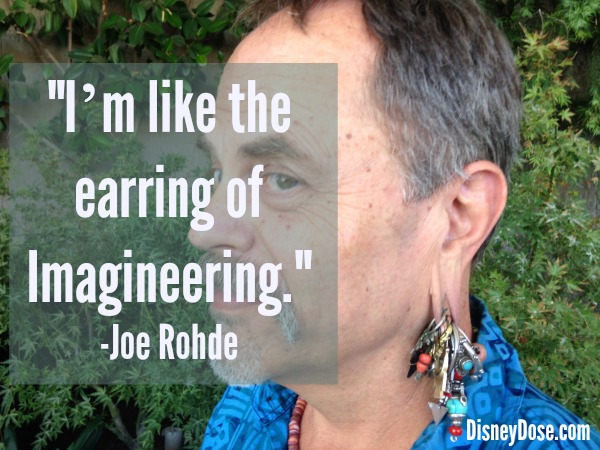
So everyone should have an earring.
Joe Rohde: No, but everyone should have a special thing, right.
Yes, something like that.
Joe Rohde: Yeah.
So I think that’s all the time you have. Thank you so much for talking to us today. I know you have a website and you have your own your social account. Where can people find you there?
Joe Rohde: I have an Instagram account. That’s @JoeRohde–most of it is Joe Rohde–and I have a Twitter account that’s @JoeRohde and a Facebook site as well. They’re all Joe Rohde. They’re pretty easy to find. They’re not much about Disney stuff. They’re mostly about travel, creativity, and adventure. That way, I can sort of keep these things very clear and separate, you know. If the Disney company wants me to blog about something, it’s really clear where that is and not very confusing. Because if you go to the site expecting to hear about Avatar, you could be really frustrated, where you’re really going to hear a whole lot about burial traditions of the Toraja highland people or Balinese ceremonial customs or some new book I’ve been reading.
Links in the resources section above.
This Week's Disneyland Secret:
This week, we featured a little know secret and story from our eBook all about Disneyland Secrets called: Disneyland Secrets: Grand Tour of Disneyland's Hidden Details.
Bonus: When you listen to the episode, receive a discount code for the book.
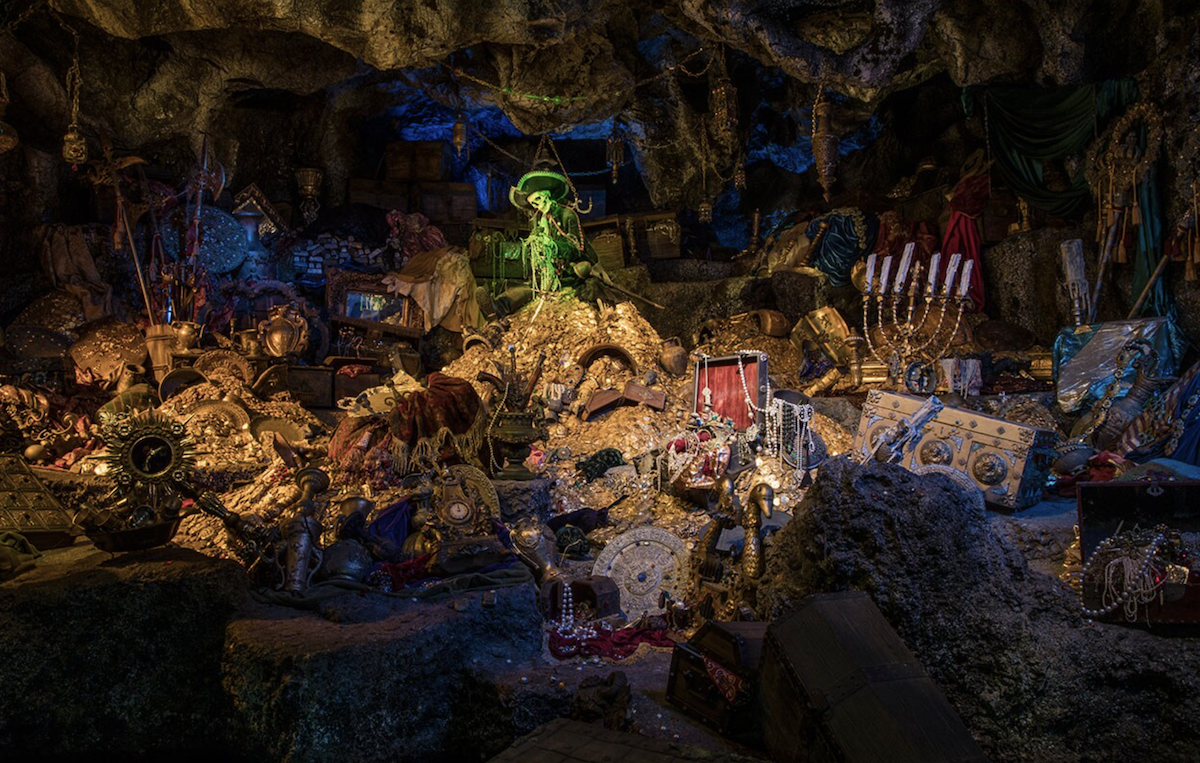
The Disneyland Pirates of the Caribbean attraction loops in on itself, so that after you go down both drops, you are directly below the load area. Then, in the bar scene with the pirates, you will see a slanted ceiling. This ceiling is actually the ramp bringing the boats out of the attraction.
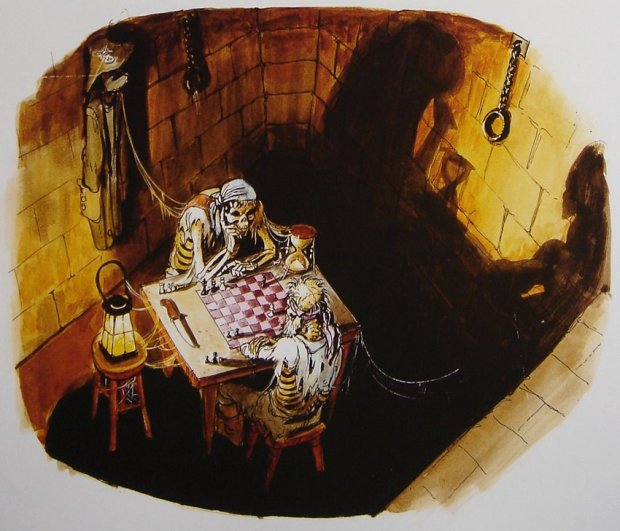
Did you know that Marc Davis designed a never ending chess game for the pirates to be playing? In the bar scene with the pirates, the dead skeletons will be locked in chess combat for eternity. For a long time, the game wasn't set up correctly, but when the characters from the Pirates of the Caribbean films were added to the attractions, they corrected the chess set and now it is never ending.
Special Thanks to You:
Special thanks to everyone who has already reviewed the show on iTunes. We were featured in the New and Noteworthy section of Travel since the inception of the podcast, and that is completely thanks to you. If you haven't had the chance yet, please leave a review on iTunes. I read every single review. Leave your feedback and show ideas.
Check out the podcast on iTunes over on Stitcher to listen and subscribe to the show. Click over to our podcast page for every episode of the Disney Dose podcast.
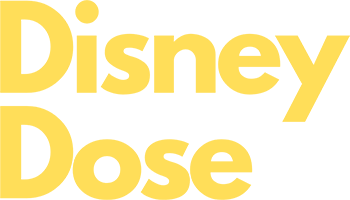
This was an excellent listen! I can’t believed Joe started from such humble beginnings and has evolved into the legend he is today. Great interview!
Everyone has to start somewhere, but Joe did have a very lucky coincidence of being one of the only Imagineers to want Animal Kingdom. Right place. Right time.
Thanks for listening.
Mr. Rohde is my favorite creative individual to hear speak about his craft! Also, I love seeing his presence on social media that gives us a look into his life! Save the Snow Leopards!
Bring back the Adventurer’s Club!!!! Loved hearing Mr. Rhode’s stories and can’t wait to see Avatar Land!
I am very excited for Avatar Land as well.
In Joe we trust.
I’ve had the pleasure of meeting him once during a signing of an opening day DAK print, and have seen him around the parks other times. The wealth of experiences and attention to detail in conjunction with his numerous contributions to Disney parks and resorts, I suspect he will one day be given a spot on a Main Street Window.
I think the question is, how would he best like to be remembered when his time is over?
That’s a good question to ask anyone. Thanks for sharing.
I always love learning different things about how the Imagineers work and Joe Rohde is interesting to listen to. I follow him on Instagram and always learn new things about the world.
Great Interview!! Thanks for making interviews like this available to us.
My pleasure.
Just finished listening to the podcast and it was so awesome to hear Joe Rohde talk about how he began with Disney and the projects he has worked on. I especially loved hearing him talk about his earrings. ^_^
Who doesn’t! 🙂
I lived hearing about Joe’s earrings. It made me wish the podcast was a video one so I could have seen which earrings he was pointing out.
It also made me wish Disney Imagineering DID do tours, that’s a tour I’d live to go on!
That’s a tour that everyone in the country would want to check out. Rumor is that they are renovating an old air hangar nearby and may present a small museum type exhibit there.
Thanks Gavin for sharing this great program. I thought Joe Rohde made some very important distinctions between directing and design that has many implications for management in general.
Keep up the good work.
Thanks very much David. I can’t wait to share our interview.
Thanks for the interview with Joe Rohde! He is a pretty interesting guy. I had the pleasure of chatting with him during opening day at Aulani & the extent of his knowledge of cultural issues whether here in Hawaii or Africa for the Animal Kingdom was just amazing… hearing this interview brought back great memories of the day I got to spend a very magical 45 minutes listening to him. Mahalo Nui Loa. Michael
Michael, how very lucky for you to be at the opening of the Aulani. Glad to bring back some memories. Aloha!
Joe Rhode is one of my favorite designers, because he not afraid to be himself!
That’s so rare at Disney…and everywhere.
Have always admired him. Such talent!
As have I. What a great creative spirit.
Very interesting to see how Joe originally got started with the Walt Disney company and how we worked his way up to Creative Director at Imagineering. Anybody wanting to become an Imagineer or with a remote interest in Imagineering should definitely listen to his interview.
Also glad you asked him about his earring! I’ve always wondered the story behind it.
Yes, everyone always seems hesitant to ask about the earring, but everyone wants to know.
Love Joe Rhode! His Instagram account is fascinating! Thanks for the interview.
What a great interview! I enjoyed hearing about Joe Rohde’s beginning at Disney. He is such an interesting person and so well spoken. I enjoyed listening to all the work that went into making Aulani. I really want to go and spend some time there now.
Thank you Gavin for a great podcast! I look forward to listening each week.
Glad that you enjoyed it Trish. We have a great episode coming out this week.
I listened to the podcast and loved it. Those were great stories from Joe. I especially loved the story of the way he chooses ear rings. Thank you.
Great interview want to see more
Loved the pirates of the Caribbean secret. It’s one of my favorite rides. I also love the interview with Joe thanks can’t wait until we have more
So glad that you like the pirates secret. When Dave told me that, he blew my mind.
Thanks for this, awesome!
Gavin, I read every Disney Dose. Thank you for such an incredible way to stay connected to you. It is a blessing in my life. Great interview! It really painted a vivid picture for me of Disneys global reach, and the joy people experience in that embrace. You have a wonderful interviewing style. I always look forward to each email. From my heart to you, Joyce
Love the article and interview. You are so lucky!
Gavin, thank you so much for sharing this. Joe is definitely one talented man. As a Florida resident, WDW AP, and an engineer, I am not only a fan of his work, but I marvel at my surroundings when in the Disney parks; continually trying to put myself in an Imagineer’s shoes (my kids think I should be one). 😉
I look forward to more of your reports and podcasts as I am new member and enjoy all things Disney.
Thanks!
=)
Great podcast! Looks like I have a new one to subscribe to. Was great to get at least a small glimpse at this career and hear about the Creative Direction / Designer distinction. I only wish it was four times as long. Thank you!
This is really cool but it sucks that WDI doesn’t take me seriously! It is my life goal to be an Imagineer, and man I would give anything to have been in your shows during the tour, but that’s not the way the cookie crumbles? With countless letters and calls, no one seems to care there. 🙁 But the one thing that sucks the most is knowing your power of your creativity but your major doesn’t apply (never mind I was born in the same neighborhood Walt Disney was.) Urrggghhhh! But I’m proud of the company, nonetheless.
Great interview! It must have been so awesome to get to hang out with Joe and hear his stories. It would be so great to work with him. Thanks for sharing!
Great interview. Interesting to hear his take on the difference between being a designer versus a creative Director…
Great interview! I loved his discussion about the level of detail in Hawaiian customs in Aulani that make Aulani a Hawaiian resort instead of a resort in Hawaii. One of many things that make Disney special.
Joe Rhode is one of my biggest inspirations in the design universe. He is so intelligent and methodical with everything he does. It was great to hear his story! He is such a unique person.
I loved listening to this interview this morning. My daughter is going to Hawaii in Dec, and I’m going to tell her to check out Aulani so she can see the Hawaiian culture Joe spoke of. I also loved hearing about his earrings, I’ve often wondered about them when I’ve seen pictures of him. Thank you so much for airing this interview:)
I loved listening to Joe. His point of view was intriguing and the background on Aulani has peaked my interest in going there. I’m a huge AK fan. His work is so impressive. Now why hasn’t he installed an Adventures Club at AK?
Loved this! I loved hearing all of these stories from the places he helped create. My question for Joe would be does he have any advice for an aspiring imagineer? I am currently a junior in college studying interior design,about to do the summer alumni college program in wdw and imagineering is all I have wanted to do since I can remember. Thank you so much for the opportunity to hear how these amazing design concepts came to be.
Thanks for the comment Martha. I have the same dream to work for the company some day. Since I was very young I hoped to become an Imagineer. Keep on dreaming and good luck this summer.
Visited Disney this past Christmas Season, family and I enjoyed everyday there. The tree of life caught my attention due to its reference to God and Creation. Mr Rohde shows how hard work and patience can take you to greater things in life.
Great interview!!!
I was privileged to have been invited to preview Pandora on Monday, and as luck would have it literally bumped into Mr. Rohde outside Flights of Passage. That led me to this article, which was a fascinating interview, indeed! I’ve read Marty Sklar’s books, and hope to enjoy similar eye-opening exposures going forward through Mr. Rohde.
Great podcast!! I’m a former Imagineer (was based in Anaheim at Disneyland). I met Joe a couple times at Disney/WDI events. Awesome man! What really got me though was your story about your visit at WDI. Your explanation is absolutely on point! Even though I worked there, seeing all the artwork, concept sketches, and models in the hallways was always fascinating. Mickey’s of Glendale was always a MUST whenever I went to the offices there. Dave Smith and the Disney Archives are more incredible than anyone imagines. Thanks for bringing back some wonderful memories for me.